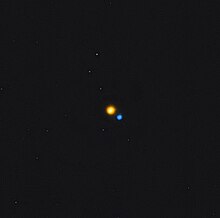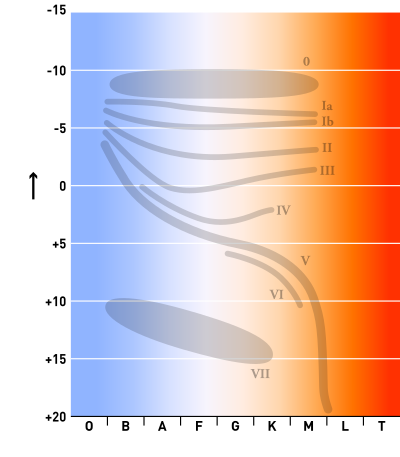B-type main-sequence star

A B-type main-sequence star (B V) is a
History
This class of stars was introduced with the Harvard sequence of stellar spectra and published in the
Later, however, more refined spectra showed lines of ionized helium for stars of type B0. Likewise, A0 stars also show weak lines of non-ionized helium. Subsequent catalogues of stellar spectra classified the stars based on the strengths of absorption lines at specific frequencies, or by comparing the strengths of different lines. Thus, in the MK Classification system, the spectral class B0 has the line at wavelength 439 nm being stronger than the line at 420 nm.[5] The Balmer series of hydrogen lines grows stronger through the B class, then peak at type A2. The lines of ionized silicon are used to determine the sub-class of the B-type stars, while magnesium lines are used to distinguish between the temperature classes.[4]
Properties
Spectral
type |
Mass (M☉) | Radius (R☉ )
|
Luminosity (L☉) | Effective temperature (K) |
Color index (B − V) |
|---|---|---|---|---|---|
| B0V | 17.70 | 7.16 | 44,668 | 31,400 | -0.301 |
| B1V | 11.00 | 5.71 | 13,490 | 26,000 | -0.278 |
| B2V | 7.30 | 4.06 | 2,692 | 20,600 | -0.215 |
| B3V | 5.40 | 3.61 | 977 | 17,000 | -0.178 |
| B4V | 5.10 | 3.46 | 776 | 16,400 | -0.165 |
| B5V | 4.70 | 3.36 | 589 | 15,700 | -0.156 |
| B6V | 4.30 | 3.27 | 372 | 14,500 | -0.140 |
| B7V | 3.92 | 2.94 | 302 | 14,000 | -0.128 |
| B8V | 3.38 | 2.86 | 155 | 12,300 | -0.109 |
| B9V | 2.75 | 2.49 | 72 | 10,700 | -0.070 |
Type-B stars do not have a
Be and B[e] stars
Spectral objects known as "Be stars" are massive yet non-
Objects known as
Spectral standard stars

The revised Yerkes Atlas system (Johnson & Morgan 1953) Besides these anchor standards, the seminal review of MK classification by Morgan & Keenan (1973)[14] listed "dagger standards" of Tau Scorpii (B0 V), Omega Scorpii (B1 V), 42 Orionis (B1 V), 22 Scorpii (B3 V), Rho Aurigae (B5 V), and 18 Tauri (B8 V). The Revised MK Spectra Atlas of Morgan, Abt, & Tapscott (1978)[15] further contributed the standards Beta2 Scorpii (B2 V), 29 Persei (B3 V), HD 36936 (B5 V), and HD 21071 (B7 V). Gray & Garrison (1994)[16] contributed two B9 V standards:
Chemical peculiarities
Some of the B-type stars of stellar class B0–B3 exhibit unusually strong lines of non-ionized helium. These chemically
Planets
B-type stars known to have planets include the main-sequence B-type HIP 78530 and HD 129116.
See also
References
- Bibcode:1981A&AS...46..193H., Tables VII and VIII.
- ^ SIMBAD, entries on Regulus, Algol A and Acrux accessed on June 19, 2007.
- Bibcode:1908AnHar..50....1P. Retrieved 2009-09-21.
- ^ ISBN 978-0691125114.
- Bibcode:1943assw.book.....M.
- S2CID 119308564.
- ^ Mamajek, Eric (2 March 2021). "A Modern Mean Dwarf Stellar Color and Effective Temperature Sequence". University of Rochester, Department of Physics and Astronomy. Retrieved 5 July 2021.
- ISBN 0387949283.
- ISBN 0521348714.
- Bibcode:1965Obs....85..166M.
- doi:10.1086/132234.
- ^ Fundamental stellar photometry for standards of spectral type on the revised system of the Yerkes spectral atlas H.L. Johnson & W.W. Morgan, 1953, Astrophysical Journal, 117, 313
- ^ MK ANCHOR POINTS Archived 2019-06-25 at the Wayback Machine, Robert F. Garrison
- ^ a b Spectral Classification, W.W. Morgan & P.C. Keenan, 1973, Annual Review of Astronomy and Astrophysics, vol. 11, p.29
- ^ Revised MK Spectral Atlas for stars earlier than the sun, W.W. Morgan, W. W., H.A. Abt, J.W. Tapscott, 1978, Williams Bay: Yerkes Observatory, and Tucson: Kitt Peak National Observatory
- ^ The late B-type stars: Refined MK classification, confrontation with stromgren photometry, and the effects of rotation, R.F. Gray & R.O. Garrison, 1994, The Astronomical Journal, vol. 107, no. 4, p. 1556-1564
- ^ The Kinematics of the Gould Belt: an Expanding Group? J.R. Lesh, 1968, Astrophysical Journal Supplement, vol. 17, p.371 (Table 1)

